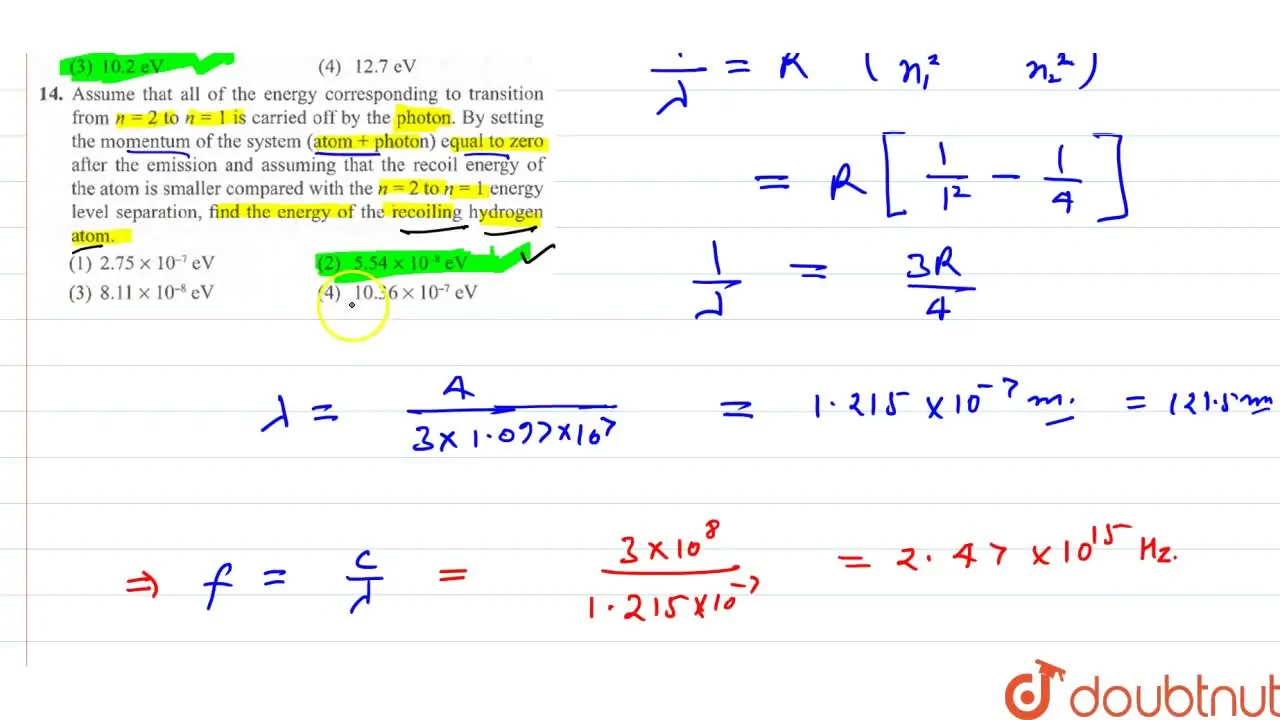The electron in a hydrogen atom at rest makes a transition from n=2 energy state to the n=1 ground state.
Assuming that all of the energy corresponding to transition from n=2→n=1 is carried off by the photon. By setting the momentum of the system (atom + photon) equal to zero after the emission and assuming that the recoil energy of the atom is smaller compared with the n=2→n=1 energy level separation , find the energy of the recoiling hydrogen atom.
2.75×10−7eV
5.54×10−8eV
8.11×10−8eV
10.36×10−7eV
The correct Answer is:B
From conservation of momentum, as the total momentum before emission is zero. The photon and atom therefore move off in oposite direction , with mv=Epho→n/C
where mandv are the mass and recoil speed of hydrogen atom Epho→n is the actual energy of the photon (less than 10.2eV) and c is the speed of light. The energy difference between the n=2→n=1 levels . E is the source of both the photon energy and the recoil kinetic energy energy of the atom.
From energy conservation , we have
E=Epho→n+12mv2
Atom being massive, we can assume that its recoil speed v and kinrtic energy are so small that E=Epho→n. Substituting Epho→n=10.2eV into the experession for mV yields.
mv=10.2eVc
The recoil kinetic energy of the hydrogen atom can now be calculated.
K=12mv2=12(mv)2m=(0.5)(10.2)2mc2
=(0.5)(10.2)2938.8×106=5.54×10−8eV
Thus , the fraction of the energy difference between the n=3→n=1 level that goes into atomic recoil energy is very small.
KE=5.54×10−810.2=5.43×10−9
That is why by equanting the photon's energy to the atomic energy level separation yields accurate answer because little energy is needed to conserve momentum.
Related Playlists
- BOOK - CENGAGE PHYSICSCHAPTER - ATOMIC PHYSICSEXERCISE - Integer4videos
ATOMIC PHYSICS
- BOOK - CENGAGE PHYSICSCHAPTER - ATOMIC PHYSICSEXERCISE - Fill In The Blanks8videos
ATOMIC PHYSICS
- BOOK - CENGAGE PHYSICSCHAPTER - ATOMIC PHYSICSEXERCISE - Multiple Correct13videos
ATOMIC PHYSICS
- BOOK - CENGAGE PHYSICSCHAPTER - ALTERNATING CURRENTEXERCISE - QUESTION BANK65videos
ALTERNATING CURRENT
- BOOK - CENGAGE PHYSICSCHAPTER - ATOMSEXERCISE - QUESTION BANK40videos
ATOMS
Similar Questions
The electron in a hydrogen atom at rest makes a transition from n=2 energy state to the n=1 ground state.
find the energy (eV) of the emitted photon.View SolutionThe frequency corresponding to transition n=1 to n=2 in hydrogen atom is.
View SolutionThe wavelength of the photon emitted by a hydrogen atom when an electron makes a transition from n = 2 to n = 1 state is :
View SolutionElectron in a hydrogen atom makes a transition from higher energy states to n=2. Calculate the maximum possible wavelengths in this transition.
View SolutionThe recoil speed of a hydrogen atom after it emits a photon in going from n=5, state to n=1 state is (in ms−1)
View SolutionThe energy of the ground state of hydrogen atom is −13.6 eV. The energy of the photon emitted in the transiton from n=4 to n=2 is
View SolutionAn electron in H atom makes a transition from n=3→n=1. The recoil momentum of the H atom will be
View SolutionThe recoil speed of a hydrogen atom after it emits a photon in going from n=5, state to n=1 state is (in ms−1)
View SolutionWhat is the wavelength of a photon emitted during a transition from n=5 state to the n=2 state in the hydrogen atom
View SolutionThe electron in a hydrogen atom makes a transition from n=n1 to n=n2 state. The time period of the electron in the initial state (n1) is eigh times that in the final state (n2). The possible values of n1 and n2 are
View Solution


